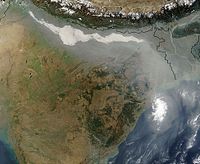
Photo from wikipedia
Abstract Light pollution is ranked high among recent forms of environmental degradation. While there have been many studies focusing on the diverse effects of artificial lighting on human health, wildlife,… Click to show full abstract
Abstract Light pollution is ranked high among recent forms of environmental degradation. While there have been many studies focusing on the diverse effects of artificial lighting on human health, wildlife, etc., studies related to the social-economic impact of light pollution have been neglected. In the current paper, we assessed the relationship between economic development and light pollution. Using collected field data of illuminance levels as a measure of light pollution and land prices as an indicator of economic development, we drew conclusions about the effects of economic development on light pollution. The results did not show an inverted-U relationship between the two variables, hence denouncing the Environmental Kuznets Curve (EKC) theory. A regression analysis test showed an R-squared value of 0.322 at p > 0.215. Looking at the obtained results, which show no statistical significance between the two variables, we advise that local light pollution regulation laws and policies be equally stringent throughout districts/cities, regardless of economic status.
Journal Title: Sustainable Cities and Society
Year Published: 2018
Link to full text (if available)
Share on Social Media: Sign Up to like & get
recommendations!